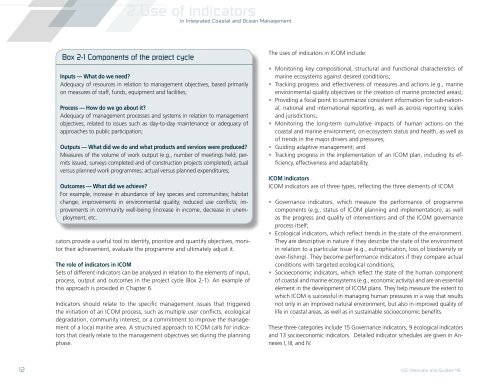5 - unesdoc - Unesco
5 - unesdoc - Unesco
5 - unesdoc - Unesco
Create successful ePaper yourself
Turn your PDF publications into a flip-book with our unique Google optimized e-Paper software.
2.Use of indicators<br />
in Integrated Coastal and Ocean Management<br />
Box 2-1 Components of the project cycle<br />
Inputs — What do we need?<br />
Adequacy of resources in relation to management objectives, based primarily<br />
on measures of staff, funds, equipment and facilities;<br />
Process — How do we go about it?<br />
Adequacy of management processes and systems in relation to management<br />
objectives, related to issues such as day-to-day maintenance or adequacy of<br />
approaches to public participation;<br />
Outputs — What did we do and what products and services were produced?<br />
Measures of the volume of work output (e.g., number of meetings held, permits<br />
issued, surveys completed and of construction projects completed); actual<br />
versus planned work programmes; actual versus planned expenditures;<br />
Outcomes — What did we achieve?<br />
For example, increase in abundance of key species and communities; habitat<br />
change; improvements in environmental quality; reduced use conflicts; improvements<br />
in community well-being (increase in income, decrease in unemployment,<br />
etc.<br />
cators provide a useful tool to identify, prioritize and quantify objectives, monitor<br />
their achievement, evaluate the programme and ultimately adjust it.<br />
The role of indicators in ICOM<br />
Sets of different indicators can be analysed in relation to the elements of input,<br />
process, output and outcomes in the project cycle (Box 2-1). An example of<br />
this approach is provided in Chapter 6.<br />
Indicators should relate to the specific management issues that triggered<br />
the initiation of an ICOM process, such as multiple user conflicts, ecological<br />
degradation, community interest, or a commitment to improve the management<br />
of a local marine area. A structured approach to ICOM calls for indicators<br />
that clearly relate to the management objectives set during the planning<br />
phase.<br />
The uses of indicators in ICOM include:<br />
• Monitoring key compositional, structural and functional characteristics of<br />
marine ecosystems against desired conditions;<br />
• Tracking progress and effectiveness of measures and actions (e.g., marine<br />
environmental quality objectives or the creation of marine protected areas);<br />
• Providing a focal point to summarize consistent information for sub-national,<br />
national and international reporting, as well as across reporting scales<br />
and jurisdictions;<br />
• Monitoring the long-term cumulative impacts of human actions on the<br />
coastal and marine environment, on ecosystem status and health, as well as<br />
of trends in the major drivers and pressures;<br />
• Guiding adaptive management; and<br />
• Tracking progress in the implementation of an ICOM plan, including its efficiency,<br />
effectiveness and adaptability.<br />
ICOM indicators<br />
ICOM indicators are of three types, reflecting the three elements of ICOM:<br />
• Governance indicators, which measure the performance of programme<br />
components (e.g., status of ICOM planning and implementation), as well<br />
as the progress and quality of interventions and of the ICOM governance<br />
process itself;<br />
• Ecological indicators, which reflect trends in the state of the environment.<br />
They are descriptive in nature if they describe the state of the environment<br />
in relation to a particular issue (e.g., eutrophication, loss of biodiversity or<br />
over-fishing). They become performance indicators if they compare actual<br />
conditions with targeted ecological conditions;<br />
• Socioeconomic indicators, which reflect the state of the human component<br />
of coastal and marine ecosystems (e.g., economic activity) and are an essential<br />
element in the development of ICOM plans. They help measure the extent to<br />
which ICOM is successful in managing human pressures in a way that results<br />
not only in an improved natural environment, but also in improved quality of<br />
life in coastal areas, as well as in sustainable socioeconomic benefits.<br />
These three categories include 15 Governance indicators, 9 ecological indicators<br />
and 13 socioeconomic indicators. Detailed indicator schedules are given in Annexes<br />
I, III, and IV.<br />
12 IOC Manuals and Guides 46

















